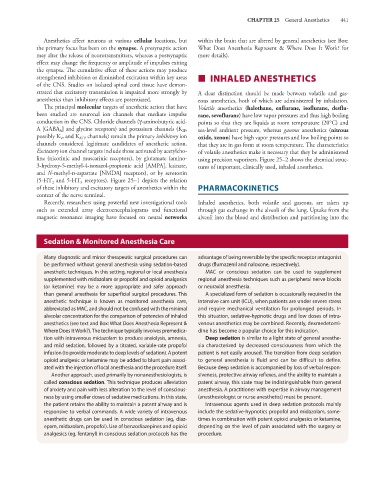Page 455 - Basic _ Clinical Pharmacology ( PDFDrive )
P. 455
CHAPTER 25 General Anesthetics 441
Anesthetics affect neurons at various cellular locations, but within the brain that are altered by general anesthetics (see Box:
the primary focus has been on the synapse. A presynaptic action What Does Anesthesia Represent & Where Does It Work? for
may alter the release of neurotransmitters, whereas a postsynaptic more details).
effect may change the frequency or amplitude of impulses exiting
the synapse. The cumulative effect of these actions may produce
strengthened inhibition or diminished excitation within key areas ■ INHALED ANESTHETICS
of the CNS. Studies on isolated spinal cord tissue have demon-
strated that excitatory transmission is impaired more strongly by A clear distinction should be made between volatile and gas-
anesthetics than inhibitory effects are potentiated. eous anesthetics, both of which are administered by inhalation.
The principal molecular targets of anesthetic action that have Volatile anesthetics (halothane, enflurane, isoflurane, desflu-
been studied are neuronal ion channels that mediate impulse rane, sevoflurane) have low vapor pressures and thus high boiling
conduction in the CNS. Chloride channels (γ-aminobutyric acid- points so that they are liquids at room temperature (20°C) and
A [GABA ] and glycine receptors) and potassium channels (K , sea-level ambient pressure, whereas gaseous anesthetics (nitrous
2P
A
possibly K , and K ATP channels) remain the primary inhibitory ion oxide, xenon) have high vapor pressures and low boiling points so
V
channels considered legitimate candidates of anesthetic action. that they are in gas form at room temperature. The characteristics
Excitatory ion channel targets include those activated by acetylcho- of volatile anesthetics make it necessary that they be administered
line (nicotinic and muscarinic receptors), by glutamate (amino- using precision vaporizers. Figure 25–2 shows the chemical struc-
3-hydroxy-5-methyl-4-isoxazol-propionic acid [AMPA], kainate, tures of important, clinically used, inhaled anesthetics.
and N-methyl-d-aspartate [NMDA] receptors), or by serotonin
(5-HT and 5-HT receptors). Figure 25–1 depicts the relation
2
3
of these inhibitory and excitatory targets of anesthetics within the PHARMACOKINETICS
context of the nerve terminal.
Recently, researchers using powerful new investigational tools Inhaled anesthetics, both volatile and gaseous, are taken up
such as extended array electroencephalograms and functional through gas exchange in the alveoli of the lung. Uptake from the
magnetic resonance imaging have focused on neural networks alveoli into the blood and distribution and partitioning into the
Sedation & Monitored Anesthesia Care
Many diagnostic and minor therapeutic surgical procedures can advantage of being reversible by the specific receptor antagonist
be performed without general anesthesia using sedation-based drugs (flumazenil and naloxone, respectively).
anesthetic techniques. In this setting, regional or local anesthesia MAC or conscious sedation can be used to supplement
supplemented with midazolam or propofol and opioid analgesics regional anesthesia techniques such as peripheral nerve blocks
(or ketamine) may be a more appropriate and safer approach or neuraxial anesthesia.
than general anesthesia for superficial surgical procedures. This A specialized form of sedation is occasionally required in the
anesthetic technique is known as monitored anesthesia care, intensive care unit (ICU), when patients are under severe stress
abbreviated as MAC, and should not be confused with the minimal and require mechanical ventilation for prolonged periods. In
alveolar concentration for the comparison of potencies of inhaled this situation, sedative-hypnotic drugs and low doses of intra-
anesthetics (see text and Box: What Does Anesthesia Represent & venous anesthetics may be combined. Recently, dexmedetomi-
Where Does It Work?). The technique typically involves premedica- dine has become a popular choice for this indication.
tion with intravenous midazolam to produce anxiolysis, amnesia, Deep sedation is similar to a light state of general anesthe-
and mild sedation, followed by a titrated, variable-rate propofol sia characterized by decreased consciousness from which the
infusion (to provide moderate to deep levels of sedation). A potent patient is not easily aroused. The transition from deep sedation
opioid analgesic or ketamine may be added to blunt pain associ- to general anesthesia is fluid and can be difficult to define.
ated with the injection of local anesthesia and the procedure itself. Because deep sedation is accompanied by loss of verbal respon-
Another approach, used primarily by nonanesthesiologists, is siveness, protective airway reflexes, and the ability to maintain a
called conscious sedation. This technique produces alleviation patent airway, this state may be indistinguishable from general
of anxiety and pain with less alteration to the level of conscious- anesthesia. A practitioner with expertise in airway management
ness by using smaller doses of sedative medications. In this state, (anesthesiologist or nurse anesthetist) must be present.
the patient retains the ability to maintain a patent airway and is Intravenous agents used in deep sedation protocols mainly
responsive to verbal commands. A wide variety of intravenous include the sedative-hypnotics propofol and midazolam, some-
anesthetic drugs can be used in conscious sedation (eg, diaz- times in combination with potent opioid analgesics or ketamine,
epam, midazolam, propofol). Use of benzodiazepines and opioid depending on the level of pain associated with the surgery or
analgesics (eg, fentanyl) in conscious sedation protocols has the procedure.

